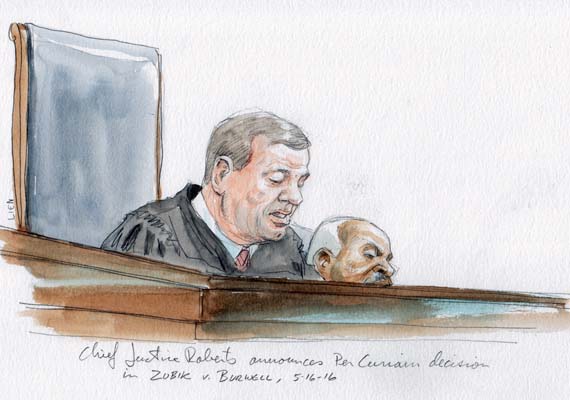A “view” from the Courtroom: Something we can live with

on May 16, 2016 at 2:35 pm
With arguments over for the Term since late last month, the Justices are now focused on “bringing down” the pending decisions. There are thirty-six as the morning begins, but the Court will make a dent in that number.
This time of year is also when the Justices may be working – struggling – to maintain majorities or to make sense of discussions on the merits that may have occurred in their private conference months ago.
That idea came to mind as we were examining the papers of the Justices available at the Library of Congress, particularly the late Justice William J. Brennan Jr.’s papers for the 1978 Term (for some reason).
We came across in Brennan’s papers a delightfully worded memo from Justice Byron R. White to his fellow Justices in late April 1979 in a case about farm labor, to which White had been assigned the majority opinion.
Memorandum to the Conference
My notes indicate that the voting on this case was scattered and uncertain, and it may be that the enclosed proposal does not wholly correspond with any of the views expressed at Conference, including mine. But it does represent something I could live with, if at least four others could.
BRW
That is a sentiment that could perhaps be framed on the wall of the Justices’ conference room. (Justice White went on to get his majority in the case, Babbitt v. United Farm Workers National Union.)
The Justices of the October Term 2015 take the bench right on time Monday, and all are present.
Justice Elena Kagan has the first opinion of the day, in Merrill Lynch, Pierce, Fenner & Smith Inc. v. Manning, about a test of federal court jurisdiction under the Securities Exchange Act of 1934.
“This is not going to be very helpful to most of you—that is, to the non-lawyers here,” Kagan says to chuckles among the crowded courtroom.
She begins to describe the dense principles involved in the case, then adds that if such language didn’t convince the non-lawyers in the crowd they “made the right decision by not going to law school, I don’t know what will.”
When she finishes, Justice Sonia Sotomayor is up next with Husky International Electronics Inc. v. Ritz, about fraudulent conveyance schemes under the federal Bankruptcy Code.
It’s a case we haven’t paid a great deal of attention to, but Sotomayor piques our interest with a discussion of one of the first bankruptcy laws of English law, the Statute of 13 Elizabeth (also known as the Fraudulent Conveyances Act of 1571).
That statute has had a “wide impact” on American law, Sotomayor says. And that leads to a win for Husky Electronics.
Justice Samuel A. Alito Jr. is up next with one of the longest-pending cases, and one that was viewed as a potential biggie – Spokeo Inc. v. Robins.
This involved a case brought by a consumer against web “people search engine” Spokeo under the Fair Credit Reporting Act of 1970. But in a time span almost as short as it would take Spokeo to spit out a set of its search results, Alito announces that because the U.S. Court of Appeals for the Ninth Circuit failed to consider both aspects of the injury-in-fact requirement for Article III standing (particularity and concreteness), the Justices are sending the case back.
We’re on to the next decision, from Justice Ruth Bader Ginsburg, in Sheriff v. Gillie. She explains the unanimous decision holding that the use of letterhead belonging to the Ohio attorney general by special counsel engaged in debt collection does not offend the federal Fair Debt Collection Practices Act.
Finally, Chief Justice John G. Roberts, Jr., has an announcement in one of the Term’s biggest cases, Zubik v. Burwell. A hush falls over the Courtroom.
Roberts immediately makes clear that today’s opinion in the case concerning objections by religious employers to the contraceptive-coverage requirements stemming from the Affordable Care Act is not his opinion. Instead, he explains, “the Court today is issuing a per curiam decision, which I will read.”
He then seemingly reads virtually all of the five-page opinion, save for citations and such. He explains that following oral argument in the case, the Court requested “supplemental briefing from the parties” on whether the disputed contraceptive coverage could be provided to the religious groups’ employees through their insurance companies, without any notice to the federal government from the groups.
“Both petitioners and the Government now confirm that such an option is feasible,” Roberts says, adopting an interpretation of the supplemental briefs that is favorable to the Court’s unusual mediation effort.
“In light of the positions asserted by the parties in their supplemental briefs, the Court vacates the judgments below and remands to the respective United States Courts of Appeals for the Third, Fifth, Tenth, and D. C. Circuits,” the Chief Justice says. “Given the gravity of the dispute and the substantial clarification and refinement in the positions of the parties, the parties on remand should be afforded an opportunity to arrive at an approach going forward that accommodates petitioners’ religious exercise while at the same time ensuring that women covered by petitioners’ health plans “receive full and equal health coverage, including contraceptive coverage.”
He stresses that the Court “expresses no view on the merits of the cases. In particular, the Court does not decide whether petitioners’ religious exercise has been substantially burdened, whether the Government has a compelling interest, or whether the current regulations are the least restrictive means of serving that interest.”
It would be better for the federal appeals court to weigh these issues based on the “significantly clarified views of the parties in the first instance,” Roberts continues.
And a couple of more things, he says: We’ll grant, vacate, and remand, the three other sets of cases that arrived here after we set argument in this group of cases. And since the federal government can rely on the religious organizations’ litigation as a form of notice about their religious objections, “the Government may not impose taxes or penalties on petitioners for failure to provide the relevant notice.”
In other words, please go away and don’t come back until we have a full complement of Justices.
The reactions to this great compromise by the parties and other observers in the next few hours will be scattered and uncertain, to coin a phrase. But for now, the decision represents something that the eight members of the Supreme Court can live with.
[Disclosure: Goldstein & Russell, P.C., whose attorneys contribute to this blog in various capacities, is among the counsel on an amicus brief in support of the respondents in this case. The author of this post, however, is not affiliated with the firm.]



